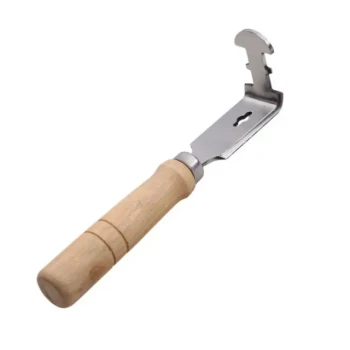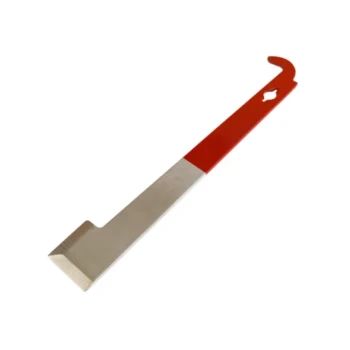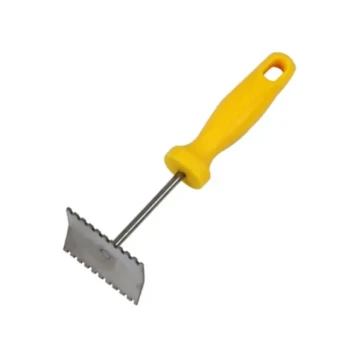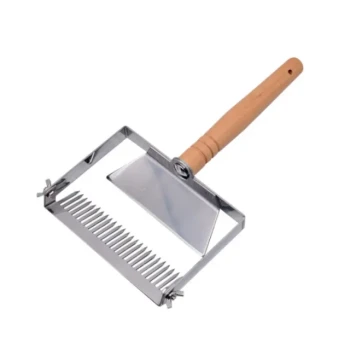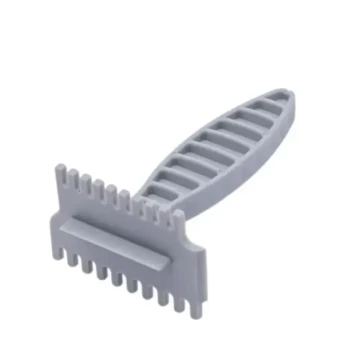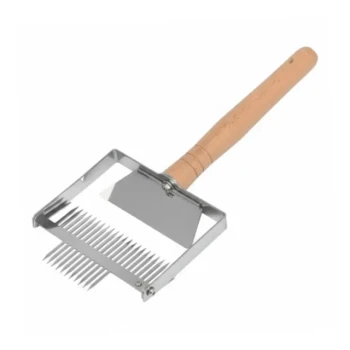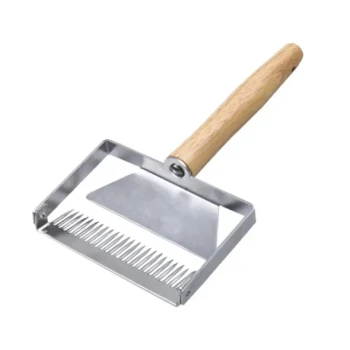To be direct, burr comb on the tops of frames should be removed at the end of every hive inspection. This timing minimizes the disturbance to the colony, as the scraping and potential honey drips occur just before you close the hive, allowing the bees to recover in peace.
The core takeaway is that removing burr comb isn't just about tidiness; it's a fundamental practice for maintaining "bee space." Proper spacing is the principle that makes modern beekeeping possible, and managing burr comb is how you enforce it.
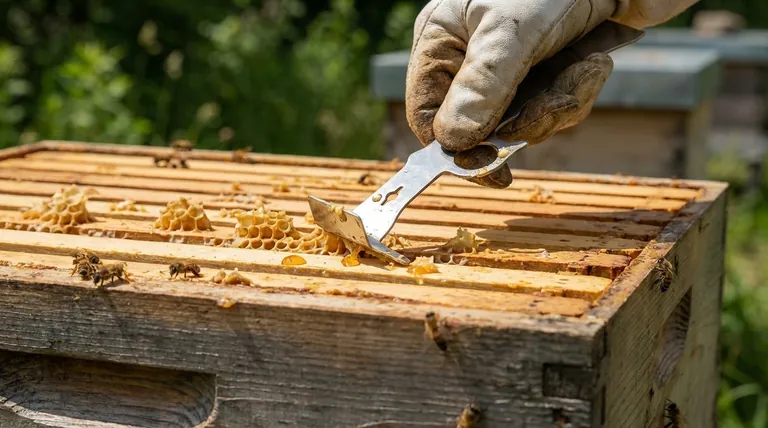
Why Burr Comb Appears: Understanding Bee Space
To effectively manage burr comb, you first need to understand why bees build it. The entire structure of a modern beehive is based on a single, critical measurement.
The Principle of Bee Space
Bee space is a specific gap, approximately 3/8 of an inch (6-9 mm), that bees will naturally keep clear of comb or propolis. It's the precise amount of room they need to move and work efficiently.
When a gap inside the hive is larger than bee space, bees will fill it with comb. When a gap is smaller, they will seal it with propolis.
Common Problem Areas
Burr comb appears wherever this bee space is violated. This most often happens on the top bars of frames, between hive bodies, or in any empty space left by improperly aligned frames.
The Consequences of Ignoring Burr Comb
Leaving burr comb in place may seem harmless, but it creates significant problems that compound over time.
Difficult and Destructive Inspections
Comb built between frames or connecting hive boxes acts like a cement. Trying to separate these components will tear the comb, spill honey, and often kill the brood or bees inside it. This makes inspections messy, stressful for the bees, and difficult for the beekeeper.
Crushing Bees
When you place a hive body or inner cover on top of frames covered in burr comb, you eliminate the proper bee space. This inevitably crushes dozens of bees, including the potential for injuring or "rolling" the queen.
Impeding Hive Function
Excess comb can block the bees' pathways for movement and ventilation. This disrupts the colony's ability to regulate temperature and humidity, especially in the brood nest.
The Proper Technique for Removal
Removing burr comb is a simple skill that requires the right timing and tool.
Timing is Key: The End of the Inspection
Always save this task for last. Scraping comb can release alarm pheromones and drip honey, which excites and agitates the colony. By doing it just before closing the hive, you minimize the duration of this disruption.
Using Your Hive Tool Correctly
Use the flat, scraper-like end of your hive tool. Hold it at a low angle to the top bar and use a smooth, slicing motion. This technique shaves the comb off cleanly without gouging the wood or needlessly injuring bees who are in the way.
What to Do with the Scraps
Quickly scrape the removed comb into a bucket or onto your upturned hive lid. Avoid dropping honey-filled comb on the ground near the hive, as this can encourage robbing from other colonies.
Understanding the Trade-offs
While necessary, removing burr comb is not without its minor consequences. Understanding them allows you to work more effectively.
The Inevitable Disturbance
Even when done carefully, scraping comb is disruptive. It is a necessary trade-off for ensuring the hive remains manageable for future inspections. A few moments of agitation now prevent a major hive tear-down later.
The Risk of Spilling Honey
Scraping comb that is full of uncapped nectar or honey will cause drips. Be mindful of this, as a significant spill can make frames sticky and, as mentioned, can be a catalyst for robbing behavior.
When to Be Cautious
If you find a large amount of drone brood in the burr comb, it can be a sign of a high Varroa mite population, as mites prefer to reproduce in drone cells. This "mistake" by the bees can actually serve as a valuable diagnostic tool for you.
Making the Right Choice for Your Goal
Your approach to burr comb should be consistent and integrated into your regular inspection routine.
- If your primary focus is routine maintenance: Scrape the top bars of all frames at the end of every single inspection to prevent any build-up.
- If you find significant comb between hive boxes: Prioritize removing this immediately, even if it's messy. It is impossible to properly inspect a hive you cannot take apart.
- If you want to prevent future build-up: Ensure all your frames are pushed tightly together and centered within the hive body to maintain correct bee space on all sides.
Consistent burr comb removal is the simple discipline that separates a chaotic hive from a calm, manageable, and productive one.
Summary Table:
| Situation | Action | Key Benefit |
|---|---|---|
| Routine Hive Inspection | Remove at the end of inspection | Minimizes bee disturbance, prevents buildup |
| Comb Between Hive Boxes | Remove immediately, even if messy | Allows for proper hive separation and inspection |
| Significant Drone Brood Present | Remove and monitor for Varroa mites | Acts as a diagnostic tool for mite population |
Ready to keep your hives healthy and manageable? Proper burr comb removal is a fundamental skill for any serious beekeeper. HONESTBEE supplies commercial apiaries and beekeeping equipment distributors with the high-quality tools—like durable hive tools—needed for effective hive maintenance. Let us help you equip your operation for success. Contact our wholesale experts today to discuss your needs.
Visual Guide
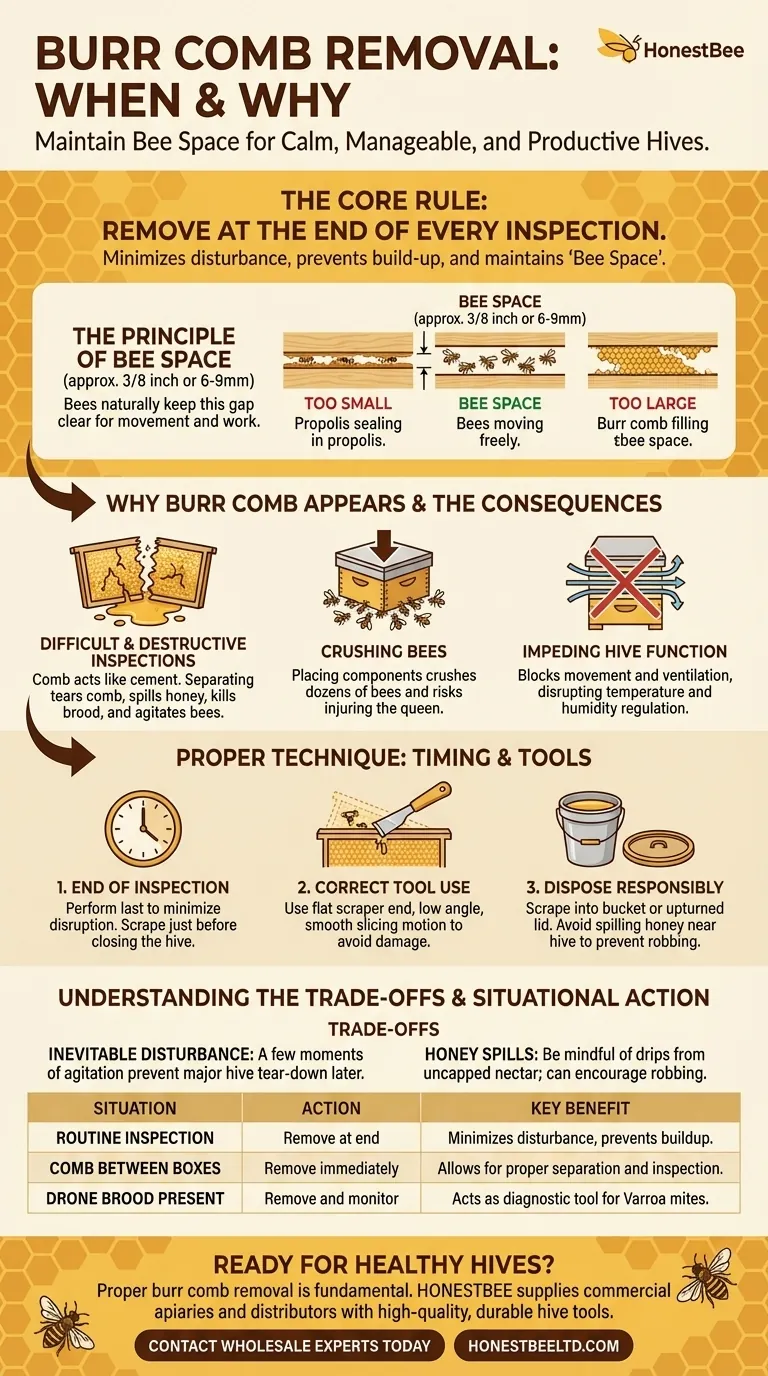
Related Products
- HONESTBEE Advanced Ergonomic Stainless Steel Hive Tool for Beekeeping
- Professional Long-Handled Silicone Honey Scraper for Beekeeping
- Professional Wide Blade Honey Scraper for Beekeeping and Honey Processing
- Professional Stainless Steel Frame Cleaner with Ergonomic Wood Handle
- Professional Stainless Steel J-Hook Hive Tool
People Also Ask
- What is a hive tool and what are its uses? Master Your Hive Inspections with the Essential Beekeeper's Tool
- Why do hive tools have a hole? Unlock the Secret to Efficient Beekeeping
- Why is it important to compare the progress of different hives? A Beekeeper's Key Diagnostic Tool
- How is a hive tool used for scraping and cleaning? Master Hive Maintenance for a Healthy Colony
- How should beekeepers handle bees when using a hive tool? Master Calm, Deliberate Techniques



